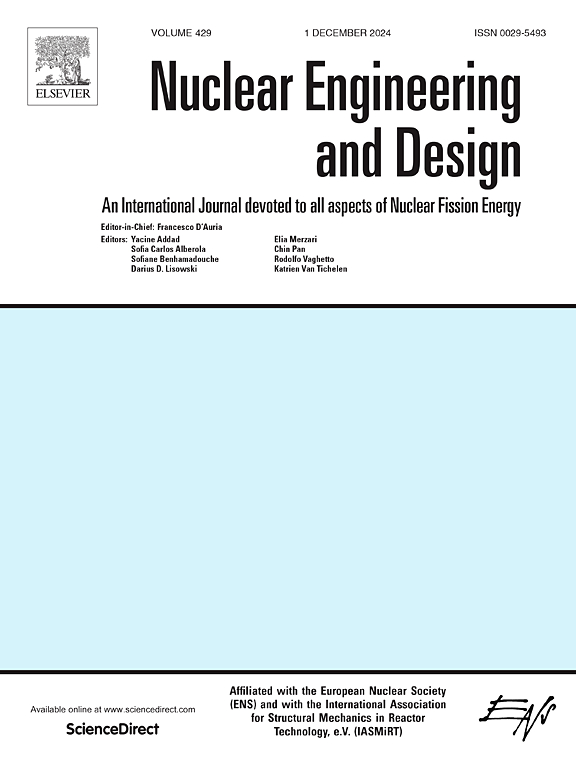Flow distribution in the primary circuit of a fast reactor: Impact with reduced number of subassemblies in the core
IF 1.9
3区 工程技术
Q1 NUCLEAR SCIENCE & TECHNOLOGY
引用次数: 0
Abstract
The primary circuit of a typical pool-type sodium-cooled fast reactor (SFR) is a complex flow network with multiple flow paths. The resistances of these flow paths vary significantly from very low to very high values. Estimation of flow fractions in these paths is essential for the design and analysis of various components in the primary circuit under various operating conditions. In the present work, the primary circuit of a typical medium-sized pool-type SFR has been modeled using the Flownex code, a commercial system dynamics code. The steady-state flow distribution in the primary circuit has been first studied and an overall flow balance has been established. Out of the total flow supplied by the primary pumps, ∼91 % flows through the core, and ∼ 93 % flows through the Intermediate Heat Exchanger (IHX). Notably, in the storage locations of the core, there is no leakage from the Grid Plate (GP, the structure on which the core subassemblies (SAs) are supported) to the bottom Core Support Structure (CSS) plenum. Instead, flow is in the reverse direction due to the high resistance offered by the sleeve holes in the storage locations.
Then, the effect of removing SAs from the fuel and storage locations of the core has been studied. The empty sleeves in the GP were modeled in 3D using Ansys® Fluent and have been coupled with the Flownex model of the primary circuit. Two different flow configurations were observed in the empty GP sleeves when the fuel SAs were removed and when the storage SAs were removed. When fuel SAs are removed, the sodium flows downwards in the empty sleeve bottom opening. However, when storage SAs are removed, the sodium flows upwards in the empty sleeve bottom opening. This happens because of the high hydraulic resistance offered by the storage SA sleeve holes. As a result, when fuel SAs are removed, the flow rates in the paths fed by the CSS plenum (main vessel cooling system path, shielding SA flow path, etc.) increase. When storage SAs are removed, the flows in these paths decrease. There is no significant change in the pump operating point when a single fuel or storage SA is removed from the core. However, when more fuel SAs are removed from the core, a change in the pump operating point is observed. For instance, the pump flow decreases by ∼ 4.1 % when seven fuel SAs are removed from the core.
求助全文
约1分钟内获得全文
求助全文
来源期刊

Nuclear Engineering and Design
工程技术-核科学技术
CiteScore
3.40
自引率
11.80%
发文量
377
审稿时长
5 months
期刊介绍:
Nuclear Engineering and Design covers the wide range of disciplines involved in the engineering, design, safety and construction of nuclear fission reactors. The Editors welcome papers both on applied and innovative aspects and developments in nuclear science and technology.
Fundamentals of Reactor Design include:
• Thermal-Hydraulics and Core Physics
• Safety Analysis, Risk Assessment (PSA)
• Structural and Mechanical Engineering
• Materials Science
• Fuel Behavior and Design
• Structural Plant Design
• Engineering of Reactor Components
• Experiments
Aspects beyond fundamentals of Reactor Design covered:
• Accident Mitigation Measures
• Reactor Control Systems
• Licensing Issues
• Safeguard Engineering
• Economy of Plants
• Reprocessing / Waste Disposal
• Applications of Nuclear Energy
• Maintenance
• Decommissioning
Papers on new reactor ideas and developments (Generation IV reactors) such as inherently safe modular HTRs, High Performance LWRs/HWRs and LMFBs/GFR will be considered; Actinide Burners, Accelerator Driven Systems, Energy Amplifiers and other special designs of power and research reactors and their applications are also encouraged.
 求助内容:
求助内容: 应助结果提醒方式:
应助结果提醒方式:


